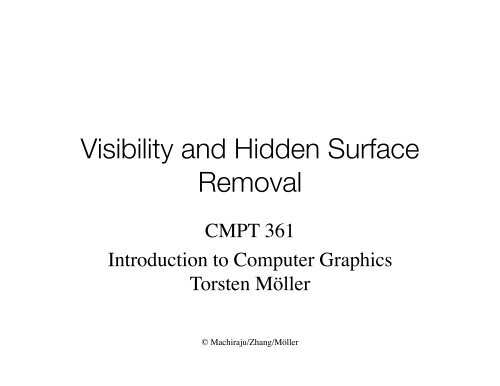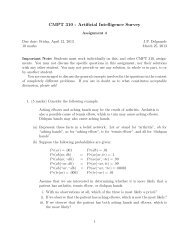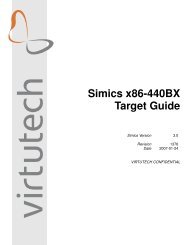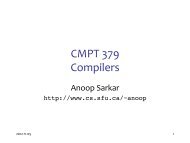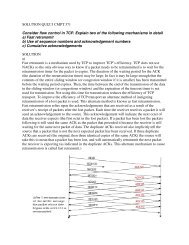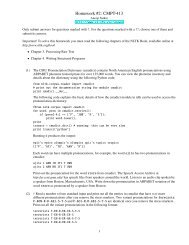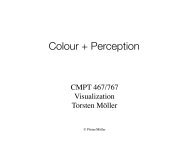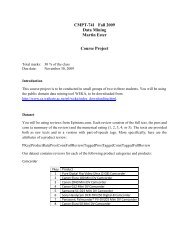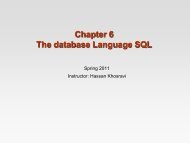Visibility and Hidden Surface Removal
Visibility and Hidden Surface Removal
Visibility and Hidden Surface Removal
Create successful ePaper yourself
Turn your PDF publications into a flip-book with our unique Google optimized e-Paper software.
<strong>Visibility</strong> <strong>and</strong> <strong>Hidden</strong> <strong>Surface</strong><br />
<strong>Removal</strong><br />
CMPT 361<br />
Introduction to Computer Graphics<br />
Torsten Möller<br />
© Machiraju/Zhang/Möller
Rendering Pipeline<br />
Hardware<br />
Modelling Transform <strong>Visibility</strong><br />
Illumination +<br />
Shading<br />
Perception,<br />
Interaction<br />
© Machiraju/Zhang/Möller<br />
Color<br />
Texture/<br />
Realism
Reading<br />
• Angel – Chapter 6.10-6.11, 8.11<br />
• Foley et al – Chapter 15<br />
• Shirley+Marschner – Chapter 12<br />
© Machiraju/Zhang/Möller<br />
3
<strong>Visibility</strong><br />
• Polygonal model - a collection of vertices<br />
© Machiraju/Zhang/Möller<br />
4
<strong>Visibility</strong> (2)<br />
• Connecting dots (wireframe) helps,<br />
• but it is still ambiguous<br />
© Machiraju/Zhang/Möller<br />
5
<strong>Visibility</strong> (3)<br />
• <strong>Visibility</strong> helps to resolve this ambiguity<br />
© Machiraju/Zhang/Möller<br />
6
<strong>Visibility</strong> (4)<br />
• Include shading for a better sense of 3D<br />
© Machiraju/Zhang/Möller<br />
7
<strong>Visibility</strong> (5)<br />
• Another Example<br />
© Machiraju/Zhang/Möller<br />
8
<strong>Visibility</strong> (6)<br />
• wireframe<br />
© Machiraju/Zhang/Möller<br />
9
<strong>Visibility</strong> (7)<br />
• Inner object visibility<br />
Back-Face Culling<br />
© Machiraju/Zhang/Möller<br />
10
<strong>Visibility</strong> (8)<br />
• Inter-object visibility<br />
© Machiraju/Zhang/Möller<br />
11
<strong>Visibility</strong> (9)<br />
• Shading<br />
© Machiraju/Zhang/Möller<br />
12
Why compute visibility?<br />
• Realism: Occlusions make scenes look more<br />
realistic<br />
• Less ambiguity: <strong>Visibility</strong> computations<br />
provide us with depth perception<br />
• Efficiency: Rendering is time consuming, so<br />
we should not have to waste time on objects<br />
we cannot see © Machiraju/Zhang/Möller<br />
13
<strong>Visibility</strong> + shading<br />
• <strong>Visibility</strong> is only one aspect for realistic<br />
rendering<br />
• <strong>Visibility</strong> + shading → even better sense of<br />
3D<br />
© Machiraju/Zhang/Möller<br />
14
Classification of algorithms<br />
• <strong>Hidden</strong> surface removal (HSR) vs. visible surface<br />
determination (VSD)<br />
– HSR: figure out what cannot be seen<br />
– VSD: figure out what can be seen<br />
• Image space vs. object space algorithms<br />
– Image space: per pixel based (image precision) ―<br />
determine color of pixel based on what is visible,<br />
e.g., ray tracing, z-buffering<br />
– Object space: per polygon or object based in object<br />
space (object precision), eg, back to front (depth sort)<br />
– In many cases a hybrid of the two is used<br />
© Machiraju/Zhang/Möller<br />
15
Image Space<br />
For each pixel in image {<br />
determine the object closest to the<br />
viewer, pierced by the projector<br />
through the pixel<br />
draw the pixel using the appropriate<br />
colour<br />
}<br />
• dependent on image resolution<br />
• simpler, possibly cheaper<br />
• aliasing a factor<br />
© Machiraju/Zhang/Möller
Object Space<br />
for each object in world {<br />
determine those parts of objects<br />
whose view is unobstructed by<br />
other parts of it or other objects<br />
draw those parts in the appropriate<br />
colour<br />
}<br />
• independent of image resolution<br />
• More complex 3D interactions<br />
• Can be more expensive, e.g., subdivision<br />
• designed first for vector displays<br />
© Machiraju/Zhang/Möller
<strong>Visibility</strong> is expensive<br />
• Image space – brute-force<br />
– O( #pixels * #objects)<br />
– 1286 x 1024 resolution <strong>and</strong> 1 million polygons<br />
– Complexity: O(1.3 x 10 12 )<br />
• Object space – brute-force<br />
– Worst-case: each object compared with the<br />
others<br />
– Complexity: O(n 2 ), e.g., 1 million polygons →<br />
O(10 12 )<br />
© Machiraju/Zhang/Möller<br />
18
How to improve efficiency<br />
• Pay attention to order in which primitives<br />
are processed, e.g., if back to front then just<br />
“paint”<br />
• Be as lazy as possible!<br />
– Costly operations are to be avoided as much as<br />
possible, e.g., use of bounding boxes<br />
– Try to make use of previous computations, e.g.,<br />
utilize coherence<br />
• Specifically …<br />
© Machiraju/Zhang/Möller<br />
19
Efficient visibility techniques<br />
• Coherence<br />
• Use of projection normalization<br />
• Bounding boxes or extents<br />
• Back-face culling<br />
• Spatial partitioning or spatial subdivision<br />
• Hierarchy<br />
© Machiraju/Zhang/Möller<br />
20
1. Coherence<br />
• Why? — Object properties, e.g.,<br />
– geometry, color, shading, <strong>and</strong><br />
– visibility situations<br />
often vary smoothly – local similarities<br />
• Utilizing coherence: reuse computations<br />
made for one part of an object for nearby<br />
parts<br />
– without change or<br />
– with only incremental updates<br />
© Machiraju/Zhang/Möller<br />
21
1. Object <strong>and</strong> area coherence<br />
• Object coherence<br />
– if two objects are well separated,<br />
only one comparison is needed<br />
between objects <strong>and</strong> not between<br />
their component faces<br />
• Area coherence:<br />
– group of adjacent pixels likely<br />
covered by the same visible face<br />
© Machiraju/Zhang/Möller<br />
22
1. Edge <strong>and</strong> face coherence<br />
• Edge coherence<br />
– an edge changes visibility only where it crosses a visible<br />
edge or when it penetrates a visible face<br />
• Implied edge:<br />
– line of intersection of two planar faces can be determined<br />
from two intersection points<br />
• Scan-line coherence<br />
– visibility information will likely change little between<br />
adjacent scan lines<br />
• Face coherence<br />
– <strong>Surface</strong> properties will likely vary smoothly across a face,<br />
so calculations on © a Machiraju/Zhang/Möller<br />
face may be modified incrementally<br />
23
1. Depth <strong>and</strong> frame coherence<br />
• Depth coherence<br />
– once the depth of one surface point is<br />
computed, the depth of the rest of the surface<br />
can be found from a difference equation (e.g.,<br />
in z-buffer) – adjacent parts of a face have<br />
similar depth values<br />
• Frame coherence<br />
– images in a sequence (e.g., animation) will<br />
likely change little from one to the other, so can<br />
reuse information from current frame – key to<br />
© Machiraju/Zhang/Möller<br />
compression 24
2. Use of projection<br />
normalization<br />
• Want to determine whether point P 1<br />
obscures P2<br />
• Need to see whether two points are on the<br />
same projector<br />
• With our projection<br />
normalization, just<br />
need to check the x<br />
<strong>and</strong> y’s of P’ 1 <strong>and</strong> P’ 2<br />
© Machiraju/Zhang/Möller<br />
25
2. Perspective Transform<br />
• Parallel projection - just check (x,y) values<br />
(need canonical volume!)<br />
• perspective - more work!<br />
• need to check if<br />
x 1 /z 1 = x 2 /z 2 <strong>and</strong><br />
y 1 /z 1 = y 2 /z 2 .<br />
© Machiraju/Zhang/Möller<br />
26
2. Perspective Transform<br />
• Can bring canonical view-volume into<br />
screen coordinates<br />
© Machiraju/Zhang/Möller
3. Bounding Objects<br />
• Operations with objects are expensive!<br />
• Can we do a quick test with an<br />
approximation of the object?<br />
• Answer - yes!<br />
• Technique - approximation through<br />
“bounding volumes” or “extents”<br />
• avoid unnecessary clipping<br />
avoid unnecessary comparisons between<br />
objects or their projections<br />
© Machiraju/Zhang/Möller<br />
28
3. Bounding Objects (2)<br />
• For rendering of projected polygons. If<br />
extents do not overlap, neither should the<br />
polygons<br />
© Machiraju/Zhang/Möller<br />
29
3. Bounding Objects (3)<br />
• If the extents overlap then either one of the<br />
following cases will apply<br />
• Typically further subdivision<br />
© Machiraju/Zhang/Möller<br />
30
3. Bounding Objects (4)<br />
• rectangular extents => bounding boxes, or<br />
bounding volumes in 3D<br />
– in general there are many possible bounding<br />
boxes<br />
– want to choose one that is efficient for a<br />
particular application (i.e. axis-aligned)<br />
– Besides comparing between objects, also used<br />
in ray-object intersection tests<br />
• spherical extend => bounding sphere<br />
© Machiraju/Zhang/Möller<br />
31
3. Bounding Objects (5)<br />
• can be used in a single dimension<br />
• no overlap between two objects if zmax2 <<br />
z min1 or z max1 < z min2<br />
• minmax testing<br />
• difficult part:<br />
find z-extensions<br />
© Machiraju/Zhang/Möller<br />
32
4. Back-face culling<br />
• Assumption: Objects are solid polyhedra,<br />
i.e., opaque faces completely enclose its<br />
volume<br />
• If viewed from outside, only exterior is<br />
visible<br />
• So we see only faces<br />
whose surface normals<br />
point towards us<br />
© Machiraju/Zhang/Möller<br />
33
4. Back-face culling<br />
• Simple test (when looking down the −z<br />
axis): examine the sign of the z component<br />
of the surface normal<br />
• z < 0 in VCS → back-facing polygon<br />
• How effective is it?<br />
– Can cull about 50% polygons<br />
in a typical scene<br />
– Does not really do occlusion<br />
– Many invisible faces still<br />
processed © Machiraju/Zhang/Möller<br />
34
5. Spatial Partitioning<br />
• break a larger problem down into smaller<br />
ones, by assigning objects to spatially<br />
coherent groups as a preprocessing step<br />
– 2D - use a grid on the image plane<br />
– 3D - use a grid over object space<br />
– Adaptive partitioning techniques for irregularly<br />
distributed objects in space: size of partitions<br />
vary<br />
• Quadtrees, octrees<br />
• BSP-trees (binary space partition trees)<br />
© Machiraju/Zhang/Möller<br />
• kd-trees<br />
35
5. Spatial Partitioning (2)<br />
© Machiraju/Zhang/Möller<br />
36
6. Hierarchy<br />
• Use (e.g., semantic) information in the<br />
modeling hierarchy to restrict the need for<br />
intersection tests at lower levels, when<br />
children are part of parent in hierarchy, e.g.,<br />
• Bounding boxes, spatial partitioning,<br />
© Machiraju/Zhang/Möller<br />
hierarchy all use very similar ideas<br />
37
<strong>Visibility</strong> algorithms<br />
• Image-space algorithms using coherence<br />
– z-buffer algorithm – use of depth coherence<br />
– Scanline algorithm – use of scanline <strong>and</strong> depth<br />
coherence<br />
– Warnock’s (area subdivision) algorithm – use of<br />
area coherence <strong>and</strong> spatial subdivision<br />
• Object-space algorithms<br />
– Depth sort – use of bounding or extent<br />
– Binary space partitioning (BSP) algorithm<br />
© Machiraju/Zhang/Möller<br />
38
z-buffer algorithm revisited<br />
• One of the simplest <strong>and</strong> most widely used<br />
• Hardware & OpenGL implementation<br />
common<br />
glutInitDisplay(GLUT_RGB | GLUT_DEPTH);<br />
glEnable(GL_DEPTH_TEST);<br />
• Use a depth buffer to store depth of closest<br />
object encountered at each position (x, y) on<br />
the screen – depth buffer part of the frame<br />
buffer<br />
• Works in image © space Machiraju/Zhang/Möller <strong>and</strong> at image precision<br />
39
The z-buffer algorithm<br />
initialize all pixels to background colour, depth to 0<br />
(representing depth of back clipping plane)<br />
for each polygon {<br />
for each pixel in polygon's projection {<br />
pz = depth of projected point<br />
if (pz >= stored depth) {<br />
store new depth pz<br />
draw pixel<br />
}<br />
}<br />
}<br />
© Machiraju/Zhang/Möller<br />
40
z-buffer: exploiting depth<br />
coherence<br />
• Polygons are scan-converted as before, but<br />
now need to compute depth values z<br />
• Assume planar polygons. On scanline y,<br />
increment x:<br />
Ax + By + Cz + D =0<br />
z =<br />
z x =<br />
z x =z<br />
Ax + By + D<br />
C<br />
A(x + x + By + D<br />
A<br />
C<br />
x<br />
C<br />
© Machiraju/Zhang/Möller<br />
Typically, Δx = 1<br />
41
z-buffer: exploiting depth<br />
coherence<br />
• From one scanline (y) to the next (y + 1):<br />
left polygon edge point: from (x, y) to (x + 1/m, y+1),<br />
where m is the slope of the polygon edge<br />
• So the new z<br />
A<br />
z x =z<br />
C<br />
z y =z<br />
A/m + B<br />
C<br />
© Machiraju/Zhang/Möller<br />
Pre-computed<br />
<strong>and</strong> stored<br />
42
z-buffer: bilinear interpolation<br />
• If the polygon is non-planar, or not analytically<br />
defined, it is possible to approximate using bilinear<br />
interpolation<br />
Depth values<br />
known at vertices<br />
Interpolate<br />
between them then<br />
on scanline<br />
• Not just for depth, can do it for color (Gouraud<br />
shading), surface normals, or texture coordinates<br />
• Subdivision or refinement may be necessary is error<br />
is too great<br />
© Machiraju/Zhang/Möller<br />
43
Depth sort algorithm<br />
• Determine a visibility (depth) ordering of objects<br />
which will ensure a correct picture if objects are<br />
rendered in that order – object-space algorithm<br />
• If no objects overlap in depth z, it is only<br />
necessary to sort them by decreasing z (furthest to<br />
closest) <strong>and</strong> render them – back-to-front rendering<br />
with painters algorithm<br />
• Otherwise, it may be necessary to modify objects,<br />
e.g., by intersecting <strong>and</strong> splitting polygons, to get<br />
depth order<br />
© Machiraju/Zhang/Möller
List Priority (2)<br />
• Depth comparisons <strong>and</strong> object splitting are<br />
done with object precision <strong>and</strong> the scan<br />
conversion is done with image precision<br />
• Depth Sort<br />
– Sort all polygons according to their smallest<br />
(furthest) z<br />
– Resolve any ambiguities (by splitting polygons<br />
as necessary)<br />
– scan convert each polygon in ascending order<br />
of smallest z (back to front)<br />
© Machiraju/Zhang/Möller<br />
45
List Priority (3)<br />
• Painter’s algorithm<br />
– simple depth sort<br />
– considers objects on planes of constant z (or<br />
non-overlapping z)<br />
– does not resolve ambiguities<br />
• Consider the following cases where<br />
ambiguities exist:<br />
© Machiraju/Zhang/Möller<br />
46
List Priority (4)<br />
• Do extents in z overlap?<br />
© Machiraju/Zhang/Möller<br />
47
List Priority (5)<br />
• Do polygons penetrate one another?<br />
© Machiraju/Zhang/Möller<br />
48
List Priority (6)<br />
• Do polygons cyclically overlap?<br />
© Machiraju/Zhang/Möller<br />
49
List Priority (7)<br />
• Five tests for visibility:<br />
– 1. do x-extents not overlap?<br />
– 2. do y-extents not overlap?<br />
– 3. is P entirely on the opposite side of Q's plane,<br />
from the viewpoint?<br />
– 4. is Q entirely on the same side of P's plane,<br />
from the viewpoint?<br />
– 5. do the projections of polygons onto the xy<br />
plane not overlap?<br />
© Machiraju/Zhang/Möller<br />
50
List Priority (8)<br />
• If these tests fail, P obscures Q. However,<br />
we can test if Q obscures P (so that the<br />
order in the list can be switched to scanconvert<br />
Q first) in the following way<br />
(replacing steps 3 <strong>and</strong> 4):<br />
– is Q entirely on the opposite side of P's plane,<br />
from the viewpoint?<br />
– is P entirely on the same side of Q's plane, from<br />
the viewpoint?<br />
© Machiraju/Zhang/Möller<br />
51
List Priority (9)<br />
• More examples -<br />
– Test 3 is true for the following<br />
© Machiraju/Zhang/Möller<br />
52
List Priority (10)<br />
• More examples -<br />
– Test 3 is false, test 4 is true for the following<br />
© Machiraju/Zhang/Möller<br />
53
Scanline algorithm<br />
• Operate at image precision<br />
• Unlike z-buffer, which works per polygon, this<br />
one works per scanline<br />
• Avoid unnecessary depth calculations in z-<br />
buffer<br />
– Depth compared only when new edge is<br />
encountered<br />
• An extension of the polygon scan-conversion:<br />
deal with sets of polygons instead of just one<br />
• Less memory-intensive than z-buffer, but more<br />
© Machiraju/Zhang/Möller<br />
complex algorithm 54
Scanline: data structure<br />
• Recall the polygon scan-conversion<br />
algorithm<br />
– Edge table (ET): stores non-horizontal <strong>and</strong><br />
possibly shortened edges at each scanline with<br />
respect to lower vertex<br />
– Active edge table (AET): A linked list of active<br />
edges with respect to the current scanline y,<br />
sorted in increasing x<br />
• Extra: Polygon table (PT): stores polygon<br />
information <strong>and</strong> referenced from ET<br />
© Machiraju/Zhang/Möller<br />
55
Scanline: data structure<br />
x_lower<br />
y_upper<br />
© Machiraju/Zhang/Möller<br />
56
Scanline Example<br />
• Another representation of our two polygons,<br />
intersected with the plane associated with a<br />
scanline<br />
© Machiraju/Zhang/Möller<br />
57
Scanline: scan example 1<br />
• At scanline y = a: AET has AB <strong>and</strong> AC<br />
– Render background color<br />
– At AB: invert in-out flag of ABC<br />
© Machiraju/Zhang/Möller<br />
Scanline coherence –<br />
no depth updates yet<br />
– Render “in” polygon ABC using information<br />
from PT<br />
– At AC: invert in-out<br />
flag of ABC<br />
– Render background<br />
color<br />
– Next scanline<br />
58
Scanline: scan example 2<br />
• At scanline y = b: AET has AB, AC, FD, FE<br />
– Render background color<br />
– At AB: invert in-out flag of ABC<br />
– Render “in” polygon ABC using information<br />
from PT<br />
– At AC: invert in-out<br />
flag of ABC<br />
– Render background<br />
– Repeat for FD & FE<br />
– Next scanline<br />
© Machiraju/Zhang/Möller<br />
59
Scanline: scan example 3<br />
• At scanline y = g: AET has AB, DE, BC, FE<br />
– Render background color <strong>and</strong> then ABC as<br />
before<br />
Computed<br />
incrementally<br />
as in z-buffer<br />
– At DE: invert in-out flag of DEF; check depth<br />
information of “in” polygons (ABC <strong>and</strong> DEF in a<br />
list of “in” polygons)<br />
– Render DEF<br />
– At BC: still render DEF<br />
if no penetration<br />
– At FE: go background<br />
– Next scanline © Machiraju/Zhang/Möller<br />
60
Scanline: scan example 4<br />
• Maintain a list of “in” polygons<br />
• Check depth information when entering into<br />
a new “in” polygon<br />
• If no penetration,<br />
there is no need to<br />
check depth when<br />
leaving obscured<br />
(occluded) polygons<br />
© Machiraju/Zhang/Möller<br />
61
Scanline: polygon penetration<br />
• If the polygons penetrate, additional processing<br />
is required: e.g., introduce a false edge L’M’<br />
• Such “self-intersections” should be avoided in<br />
modeling <strong>and</strong> detected beforeh<strong>and</strong> – meshes<br />
are mostly OK © Machiraju/Zhang/Möller<br />
62
Scanline problems<br />
• Beware of large distances <strong>and</strong> large<br />
polygons with the z-buffer algorithm.<br />
• Problems with perspective projection can<br />
arise<br />
• the visible<br />
polygon<br />
may not<br />
be correctly<br />
determined<br />
© Machiraju/Zhang/Möller<br />
63
BSP algorithm<br />
• Binary space partitioning of object space to<br />
create a binary tree – object-space algorithm<br />
• Tree traversal gives back-to-front ordering<br />
depending on view point<br />
• Creating/updating the tree is time- <strong>and</strong><br />
space-intensive (do it in preprocessing), but<br />
traversal is not – efficient for static group of<br />
polygons <strong>and</strong> dynamic view<br />
• Basic idea: render polygons in the half-<br />
© Machiraju/Zhang/Möller<br />
space at the back first, then front 64
Building the BSP trees<br />
• Object space is split by<br />
a root polygon (A) <strong>and</strong><br />
with respect to its<br />
surface normal (in front<br />
of or behind the root)<br />
• Polygons (C) which lie<br />
in both spaces are split<br />
• Front <strong>and</strong> back<br />
subspaces are divided<br />
recursively to form a<br />
© Machiraju/Zhang/Möller<br />
binary tree 65<br />
B<br />
D<br />
C 1<br />
C 2<br />
A<br />
E<br />
B E<br />
front back back<br />
C 1<br />
front<br />
A<br />
back<br />
D C 2
BSP trees traversal<br />
DrawTree(BSPtree, eye) {<br />
if (eye is in front of root) {<br />
DrawTree(BSPtree→back, eye)<br />
DrawPoly(BSPtree→root)<br />
DrawTree(BSPtree→front,<br />
eye) }<br />
else {<br />
DrawTree(BSPtree→front, eye)<br />
DrawPoly(BSPtree→root)<br />
DrawTree(BSPtree→back, eye) }<br />
}<br />
© Machiraju/Zhang/Möller<br />
66
BSP traversal example<br />
• Rendering order:<br />
• D, B, C1, A, E, C2<br />
• E, C2, A, D, B, C1<br />
C 2<br />
B<br />
A<br />
C 1<br />
D<br />
View point<br />
E<br />
A<br />
front back<br />
B E<br />
front back back<br />
C 1<br />
D C 2<br />
© Machiraju/Zhang/Möller
Area subdivision<br />
• Divide-<strong>and</strong>-conquer <strong>and</strong> spatial partitioning<br />
in the projection plane. Idea:<br />
– Projection plane is subdivided into areas<br />
– If for an area it is easy to determine visibility,<br />
display polygons in the area<br />
– Otherwise subdivide further <strong>and</strong> apply decision<br />
logic recursively<br />
– Area coherence exploited: sufficiently small<br />
area will be contained in at most a single visible<br />
polygon<br />
© Machiraju/Zhang/Möller<br />
68
Warnock’s subdivision<br />
• Divide the (square) screen into 4 equal<br />
squares.<br />
• There are 4 possible relationships between<br />
the projection of a polygon <strong>and</strong> an area<br />
© Machiraju/Zhang/Möller<br />
69
Warnocks Algorithm (2)<br />
– All Disjoint: background colour can be<br />
displayed<br />
– One intersecting or contained polygon: fill with<br />
background <strong>and</strong> then scan-convert polygon<br />
inside area<br />
© Machiraju/Zhang/Möller<br />
70
Warnocks Algorithm (3)<br />
– Single surrounding polygon: fill with colour<br />
from surrounding polygon<br />
– More than one polygon intersecting, contained<br />
in, or surrounding, but 1 surrounding polygon<br />
in front of others: fill with colour from front<br />
surrounding polygon (see below)<br />
© Machiraju/Zhang/Möller<br />
71
Warnock’s Algorithm<br />
• How to determine that case 4 applies (no<br />
polygon penetration)?<br />
– Check for depth values of all planes of the polygons<br />
involved at the four corners of the square area<br />
– If a surrounding polygon wins at all four depth<br />
values<br />
© Machiraju/Zhang/Möller<br />
72
Warnock’s Algorithm<br />
• If none of the cases 1 – 4 apply, the area is<br />
subdivided<br />
• If none of the cases 1 – 4 is true <strong>and</strong> cannot<br />
subdivide any more, e.g., at pixel precision,<br />
(that is unlucky) then we can assign a color<br />
of the closest polygon from the center of the<br />
pixel for example<br />
© Machiraju/Zhang/Möller<br />
73
Warnock’s: example<br />
© Machiraju/Zhang/Möller<br />
74
Final issues on area subdivision<br />
• Warnock’s algorithm subdivide using<br />
rectangles<br />
• It is possible to divide by polygon boundaries<br />
– Weiler-Atherton algorithm ([F] Section<br />
15.7.2)<br />
• Can even do area subdivision at subpixel level<br />
– Expensive obviously – full area-subdivision<br />
visibility at each pixel<br />
– Why? Use average color from all polygons that<br />
cover a pixel – antialiasing technique (later in the<br />
© Machiraju/Zhang/Möller<br />
course)<br />
75


